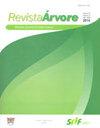鸢尾的出苗、初期生长和幼苗质量:对遗传育种和保护的补贴
IF 0.8
4区 农林科学
Q4 FORESTRY
引用次数: 0
摘要
摘要到目前为止,鸢尾幼苗的商业化生产都是在没有任何遗传控制的情况下进行的。因此,我们提出了两个实验来检验种子树在苗期通过种子对后代的影响,并验证变量之间的相关性。我们在温室中进行了第一次试验,每周评估出苗情况,持续42天。在温室的出口处,我们估计了60天的存活率。我们在阴凉的房子里进行了第二次实验,后来又在阳光充足的地方进行了第二次实验。我们分别在播种后90、120、150和180天对幼苗的高度、直径和存活率进行了评估。在180 d时,我们量化了茎部、根和总干物质重,并计算了Dickson质量指数(DQI)。白桦种子树通过种子对其后代的出苗率、生长特性和幼苗质量有显著影响。所有种子树在温室出口的幼苗成活率均较高,为72.2% ~ 97.2%。所有的种子树都表现出更大的生物量分配在幼苗的茎部,其中一些种子树的生物量分配比例更明显。羽化率与其他性状的相关值均为正相关,但均不显著。高度、直径、干质量与DQI呈显著正相关,从中量级到高量级。由于其非破坏性,直径可被认为是评价白桦幼苗质量最合适的实用指标。我们的研究结果有助于实施更有效的保护和繁殖策略,有助于了解在Campos Rupestres环境中白桦的幼苗生产和生态系统服务恢复行为。本文章由计算机程序翻译,如有差异,请以英文原文为准。
EMERGENCE, INITIAL GROWTH, AND SEEDLING QUALITY OF Eremanthus incanus: SUBSIDIES FOR GENETIC BREEDING AND CONSERVATION
ABSTRACT So far, the commercial production of Eremanthus incanus seedlings has been performed with seeds without any genetic control. Thus, we propose two experiments to examine seed-trees' effect on their descendants via the seminal in the nursery phase and verify the correlation between the variables. We installed the first experiment in a greenhouse and evaluated seedling emergence weekly for 42 days. At the exit of the greenhouse, at 60 days, we estimated survival. We conducted the second experiment in a shade house and, later, in full sun. We evaluated seedlings' height, diameter, and survival at 90, 120, 150, and 180 days after sowing. At 180 days, we quantified shoot, root, and total dry matter weight and calculated the Dickson Quality Index (DQI). The effects of E. incanus seed-trees on their descendants via the seminal were significant for emergence, growth characteristics, and seedling quality. The seedling survival rate at the greenhouse exit was high for all seed-trees, ranging from 72.2% to 97.2%. All seed-trees showed greater biomass allocation in the shoots of the seedlings, with this proportion being more pronounced in some of them. Although not significant, the correlation estimates between the emergence rate and the other traits were all positive. The correlations between height, diameter, dry mass, and DQI were significant and positive, from moderate to high magnitude. Due to its nondestructive nature, the diameter can be considered the most suitable practical indicator to evaluate the quality of E. incanus seedlings. Our results substantially contribute to implementing more effective conservation and breeding strategies, helping to understand the behavior of E. incanus in Campos Rupestres environments regarding seedling production and recovery of ecosystem services.
求助全文
通过发布文献求助,成功后即可免费获取论文全文。
去求助
来源期刊

Revista Arvore
FORESTRY-
CiteScore
1.00
自引率
0.00%
发文量
32
审稿时长
4-8 weeks
期刊介绍:
A Revista Árvore é um veículo de comunicação científica da Sociedade de Investigações Florestais – SIF. O jornal é de acesso gratuito, revisado por pares, que publica bimestralmente trabalhos científicos originais no campo da Ciência Florestal. As áreas temáticas para publicação são: Ambiência e Conservação da Natureza, Manejo Florestal, Silvicultura e Tecnologia da Madeira e Utilização de Produtos Florestais.
A política editorial visa manter alta conduta ética em relação à publicação e aos seus funcionários, rigor na qualidade dos artigos científicos, seleção de revisores qualificados, respeito profissional aos autores e processo de tomada de decisão imparcial. A Revista Árvore publica artigos apenas em inglês.
Artigos de revisão podem ser publicados se houver uma discussão relevante resumindo o estado da arte sobre o assunto. A revisão estrita da literatura não é aceita.
 求助内容:
求助内容: 应助结果提醒方式:
应助结果提醒方式:


